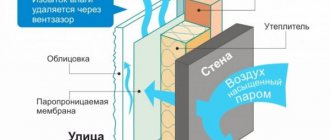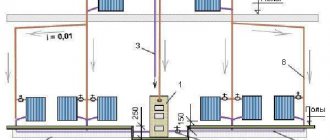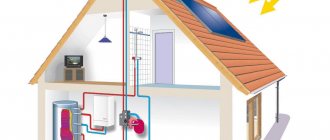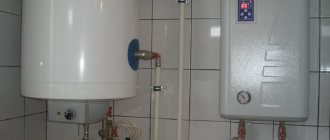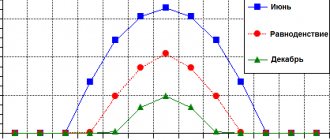Vertical radiators for liquid heating systems are conventional heating devices. The main difference between such models and traditional ones is their non-standard dimensions: the width of the radiator is much smaller than the height. Conventional batteries are installed, as a rule, under window openings, while vertical ones can be placed on walls in any room, including in niches, openings or in rooms where there are no windows at all. Vertical batteries are no different from horizontal ones in the main parameters:
- material – cast iron, steel, aluminum, bimetal;
- design – sectional, panel, tubular;
- connection method to the heating system pipelines - diagonal, side, bottom.
The main difference between vertical models is their original design, which combines a wide variety of shapes and color shades. This allows them to fit organically into the most sophisticated interiors.
What are vertical heating radiators
When purchasing real estate, you often have to make repairs, including replacing heating appliances. Even with the usual modernization of an apartment, it is often necessary to change the batteries, which are hopelessly clogged and practically do not heat.
In addition to the usual models located under window openings, today there are vertical analogues installed on walls.
When studying offers from heating equipment catalogs, potential buyers often pay attention to vertical radiators for heating an apartment. They differ from classic batteries in their unusual design and proportions, as well as in the absence of the need to look for a special place for them.
As a rule, a vertical heater is a painted metal panel or a tubular cascade in a modern design. They fit perfectly into most styles, have excellent thermal output and excellent appearance, as in the photo.
It is logical that heating radiators are called vertical, the sections of which are located vertically.
Vertical designer radiators are distinguished by their design and more respectable appearance. Behind the elite appearance are ordinary pipes for supplying hot water or antifreeze, but their price is justified by the harmonious appearance.
Wall-mounted vertical radiators - aesthetics and functionality
Vertical wall radiators are an excellent alternative to the usual radiators under windows. In addition, in modern apartments you can often find panoramic glazing on the floor. In this case, ordinary radiators will not work. Vertical radiators look very unusual and stylish; they are created not only for heating, but also for decoration. Such heating devices can become a real piece of art and an unusual decoration for your home.
By design, these are ordinary water batteries, only in a new interpretation. Designers carefully consider the appearance of such devices so that they not only do not spoil the interior, but also make it more interesting and modern.
Connection terminals can be either in the floor or in the wall. Therefore, for each option you need to select the appropriate battery model.
Wall batteries really look unusual and stylish.
Some models look very graceful and elegant. They consist of one row of thin, neat tubes.
Other options are more brutal and massive in appearance, which is very suitable for some interior styles.
Vertical batteries can be quite narrow, consisting of only a few sections. Therefore, they are convenient to place even in the smallest partitions. And due to the height of the equipment, such a narrow device is quite enough to heat a standard room.
The elements of vertical radiators are not only round and voluminous, but also flat, made in the form of plates.
If the room is large and one battery is not enough, you can use two. Moreover, thanks to the decorative properties of such radiators, they look great on the wall, creating a beautiful composition.
Due to their attractive appearance, vertical radiators are even used as partitions for zoning space.
The design of such batteries can be very unusual and original. For example, there are semicircular models.
A similar principle of arrangement of elements is used for corner radiators. These options are designed specifically for external corners.
Batteries in the shape of the letter “X” look impressive. Both parts can have the same color or different.
Some models do not look like batteries at all, but simply look like decorative panels. Especially if the connection points are hidden behind the case and are not visible.
Options made from slightly curved wave tubes are elegant and beautiful.
Some options have particularly unusual or futuristic designs.
For those who love practicality, multifunctional models are suitable. For example, vertical radiators with mirrors will fit perfectly into any room in the house.
There are radiators with a bar for drying towels.
Batteries with hooks will be no less useful.
There are even quite large models that have both a mirror and hooks.
Brightly colored radiators look truly elegant and extraordinary in the interior. This is a very fashionable solution for modern apartments.
Modern designers are constantly searching for new ideas. Thanks to this, such beautiful and at the same time functional things appear. Vertical radiators not only heat your home, but are also real decorations. There are an incredible number of models and sizes, so you can choose a unique and unusual option for your home.
Pros and cons of vertical format radiators with bottom connections
The excellent design of a vertical panel or tubular heating radiator is the main advantage of this format. They fit perfectly into most modern design concepts. Some models can hardly be called a “battery” until you touch a warm surface with your hand.
A distinctive feature of such systems is their orientation in height with a reduced width.
Vertical units are installed in addition to horizontal equipment or instead of traditional batteries. It is easier to find a place for them when there is no window sill niche or it is not spacious enough to install a large heating unit. They are characterized by:
- high thermal output;
- variety in color and design;
- ease of installation (all parts for installation are included);
- space saving (a little space in width on any free wall).
Among the “disadvantages” are:
- more time is needed for “acceleration” during primary heating;
- uneven heating at high altitude and insufficient pressure in the system;
- relatively high price;
- tendency to clog in the lower part of the radiator, where the coolant is supplied.
The main sign of contamination is cold radiators and warm pipes that are connected to them. Since all the dirt accumulates at the bottom, they have to be disconnected periodically and purged or washed. An exhaust valve must be installed at the top point to remove excess air.
Thanks to this arrangement, it is possible to fit such batteries even into a small space, maintaining the required amount of thermal energy.
Advantages of using vertical heating radiators
Any vertical heating radiator is a modern device, thanks to which you can create the most comfortable living atmosphere in a room. Such batteries can easily highlight the features of the interior, increasing its attractiveness and originality.
Vertical heating radiators differ from traditional options for heating systems in their advantages:
- Light weight (except, actually, cast iron batteries),
- Wide range of design colors and finishing options. You can choose any batteries, from painted to chrome-plated,
- Compact sizes. Due to the vertical location of the battery, it can be placed literally in any free “crack” in the room,
- Wide selection of fastening elements. For each type of vertical heating radiators, you can advantageously select your own fastening elements, which will ensure not only high-quality and reliable fastening, but also will not at all affect the appearance of the structures,
- Easy to install. Vertical radiators of a heating system can be installed without any problems even with your own hands - people will not have any problems with the process even without special training,
- Possibility to get rid of heating radiators under windows. Vertical batteries, due to their shape and size, can be installed on any wall in the house, and not under the windows, as is most traditionally customary in our country,
- Fast, efficient and high-quality heating of indoor air. At the same time, the heat transfer area of vertical batteries is much larger than that of traditional horizontal devices (due to the design shape).
A vertical radiator is an excellent choice for the heating system of any property. Due to the variety of materials, shapes and sizes, there will be no problems when installing vertical batteries, both in an autonomous and centralized heating system of an apartment or private house.
When choosing vertical radiators of a particular model, you must take into account many parameters, ranging from the functional purpose of the room, its area and ending with the climatic features of the region.
It is also very important to base it on your budget - the price range of radiators is very wide, there are both budget options and expensive models made by professional designers. Permanent address of the article
Types of vertical radiators on the wall
Today, many interesting models of heating equipment have been developed that can easily replace old rusty pipes and clogged cast iron accordions. New types of batteries, including vertical ones, are classified according to different criteria:
- metal (cast iron, steel, aluminum, bimetal);
- mounting method (floor with legs, wall with brackets);
- functionality (radiators and heated towel rails);
- by external design (tubular, panel, sectional);
- according to the method of connection to the heating system (side, diagonal, bottom “saddle”).
The systems can be located almost from the floor to the flow, up to the height of a person.
From all the variety you can choose the most suitable model. It should be recalled that vertical tubular panels fit perfectly into the design of an insulated balcony or loggia. They are mounted on the end walls on both sides to ensure full convection.
By spreading infrared thermal radiation (similar to solar heat) at the height of a person, they provide increased indoor comfort.
Cast iron heaters
Cast iron products are considered “classics”, since this is the format of heating equipment that has been used for almost a century. The main disadvantage is that they are heavy and bulky; there are certain difficulties when installing them yourself.
Due to their high performance properties, cast iron batteries are very popular.
An important advantage of this type of vertical radiators is their inertness to the composition of the coolant. They do not react to the composition of water and its acidity, and are not prone to corrosion. However, organic suspension, calcium deposits and rust, which was brought from the heating circuit pipes, quickly accumulate in cast iron sections.
Steel radiators
The most common material for heating devices. Stainless steel is lightweight and ductile for the manufacture of batteries of any format. But we can say that it is “stainless” only conditionally. In terms of other performance parameters, these batteries have practically no equal.
Steel radiators are quite in demand, which is primarily due to their affordability.
Modern alloys are quite resistant to chemical reactions. Internal chrome plating of surfaces minimizes the corrosion process. But over time, small abrasive particles of the coolant cause damage to the protective layer. The air and moisture that remains in heating devices in the summer after draining the water gradually destroys the “stainless” steel.
Aluminum batteries
A lightweight, ductile metal, aluminum has proven itself well in vertical radiators. They do not require additional painting, searching for a suitable decorative shield or other design technique.
The product is lightweight, neat in appearance, durable and affordable.
However, all-aluminum radiators for urban environments are rarely preferred. Most often, bimetallic models are made from this metal, where only the external parts are aluminum. The coolant flows through a steel tube. This soft ductile metal also has disadvantages:
- incompatible with copper, which is found in heating boiler parts;
- connecting units cannot withstand the maximum load during water hammer (cracks, depressurization, leaks are possible);
- With sudden mechanical shocks, the radiator may lose its impeccable appearance (scratches, dents).
Lightweight products of modern design, resistant to corrosion are the main positive characteristics. Vertical models are often produced not only from aluminum, but from bimetal and in the form of combined design proposals.
The products are characterized by high thermal efficiency, but overheating is possible in the fin area.
Helpful information! The catalogs contain not only aluminum radiators, but also offers in the form of vertical heated towel rails and horizontal benches with wooden seats for heated bathrooms.
These are models with different functionality, but they are more suitable for a closed heating circuit in cottages and large country buildings.
The most efficient and reliable systems consisting of an inner and outer pipe.
Bimetallic heating devices
This type combines the advantages and disadvantages of 2 types of heating devices for a comfortable apartment microclimate:
- aluminum;
- steel.
Typically this is a steel tubular base in an aluminum casing. A mixed-type bimetallic battery withstands water hammer and low quality warm water in urban systems. But over time, the protected inner layer of galvanization wears off under the influence of small abrasive particles, they rust and fail.
The material for the outer pipe is usually aluminum with an enamel coating.
Externally, vertical bimetallic panels are perfectly perceived in a modern interior. They do not have to be hidden behind curtains, screens or furniture, as is often necessary with old cast iron products.
Main types of radiators
Based on the material of manufacture and design, vertical radiators are divided into several main types:
Cast iron radiators
Classically verified and long ago becoming traditional, the material is not always used for the production of unpresentable “accordions”. Modern options can have a stylish look, corrugated or smooth surfaces, a variety of colors, decorated with casting and blackening, and fit not only into rooms in a “retro” or “Soviet” style.
Today they are produced using artistic casting technology, complemented by suitable taps, plugs, stands and holders. These are tall radiators rather than vertical ones because cast iron retains heat well and there is no need for a large surface area. Their disadvantages are the instability of cast iron to directed strong point impacts and heavy weight, so the sections are quite difficult to securely fasten to walls or partitions; they are equipped with legs and stand on the floor in addition to wall fastenings.
Steel radiators
Steel radiators have high heat transfer, heat up very quickly, are lightweight and easy to install, regardless of the size and number of sections. However, due to their design, they do not withstand water hammer, and when connected to a central heating system, they can become a source of leaks. Rapid cooling makes them energy-intensive and unsuitable for autonomous heating systems. They are divided into three types: panel, tubular and sectional.
Vertical panel radiator
Vertical panel radiator is the most popular model. A neat appearance, smooth surface, many shade options and the ability to hold independently applied designs allow them to harmoniously fit into any interior in the form of decorative panels.
Models with convectors create an excellent thermal curtain when placed under windows. Vertical radiators of this type are often installed under alpine vents, skylights, or to heat staircases and interfloor passages in private homes. If the apartment has only one floor, then a convector is not needed, since the thermal curtain will be created under the ceiling, and the cost of models without it is much less.
Tubular vertical batteries
Tubular vertical batteries look very original and allow you to create structures up to three meters in height, which is perfect for rooms with high ceilings. They can have any color, shape (even twisted ornaments and crossed knots) and bends, as they are made from separate pipe sections and connected by welded manifolds, which allows them to satisfy the most picky designers. Such designs rarely have sharp corners and are safer for children's rooms. The presence of welded seams also makes them vulnerable to water hammer, so the likelihood of leaks in centralized heating systems is high.
Sectional batteries
Sectional batteries made of steel do not have very high performance parameters, but they are attractive due to their low price and detachable design. The ability to change a section, increase or, conversely, reduce the surface is sometimes decisive when purchasing. Sections are not produced above two meters and look very neat in appearance, and they are often given the appearance of artistically designed panels. Very low weight allows connection and installation on walls and partitions made of low-strength materials.
Vertical radiators
Vertical radiators made of aluminum are quite capricious regarding the quality of the coolant, they are characterized by uneven heating of the structure, and not all models have an anti-corrosion coating. However, they are relatively easy to install, light in weight, have a high heat transfer coefficient and are aesthetically pleasing.
There are models in the production of which an anodizing cycle is added - they tolerate high pressure well and do not require high-quality coolant, but their price is much higher than usual.
The advantage of such radiators is that the number of sections for each room is calculated separately, so in small rooms you can often find narrow radiators.
The shelf life of aluminum non-removable radiators is typically stated to be from 20 to 25 years, but with proper care they can last much longer. The manufacturer gives a shorter warranty period for collapsible structures, but they can also last a very long time with high-quality coolant and proper operation.
Vertical bimetallic radiators
Vertical bimetallic heating radiators are considered the most efficient and reliable. They are made of internal pipes made of stainless alloy or copper, which are in direct contact with the coolant and an external heat exchange casing made of aluminum with an enamel coating. Outwardly, they are no different from aluminum radiators, but significantly superior to them in performance, which is especially valuable at the height of the heating season, and justifies their higher cost. Installed in an apartment with a central heating system, they can prevent leaks due to pressure changes in the pipes.
Structurally, there are also collapsible and non-dismountable options, each of which is designed for a certain thermal power, and most models are equipped with thermostats. Many examples of vertical radiators, including designer models, can be seen on the KZTO website.
What size of wall-mounted water heating radiator to choose
If we talk about the dimensions or dimensions of vertical radiators for an apartment, then they are less limited. Horizontal type batteries should be placed in a niche under the window. There are certain requirements that are important to comply with in order to have maximum thermal output.
The decisive criterion when choosing a heating radiator is its heat transfer.
Popular height formats range from 1200 – 1500 and up to 2000 mm. Large panels are used in rooms with high ceilings and specific “concrete jungle” rooms:
- loft apartments;
- apartments with panoramic views;
- housing with “French” windows (low window sill);
- apartments with hinged balcony doors with glazing.
The power of the system is selected taking into account the area of the room, the presence and number of walls in contact with the street.
Vertical wall-mounted thermal units have fewer format restrictions. Of course, compact designer panels are easier to integrate into interior design. But tall and deep models give off more heat, provided that they are not dirty and connected correctly.
Installation Features
Due to the physical characteristics of the distribution of warm air, certain requirements apply to the placement of heating radiators. Traditionally, they are installed under windows, below the window opening, to block the flow of cold air from the window and keep the room warm. What to do if the windows are panoramic, or the part of the wall from the floor to the window sill is too small to install the battery?
Vertical heating radiators for an apartment or office with panoramic windows and low window sills are an ideal solution to retain heat and implement many interior solutions. They are also suitable if the area where wall batteries should be installed is too narrow for the installation of traditional options.
Also, do not discount the design of the room - many models can please you not only with practical functions, but also perfectly serve as decorative elements to complement the interior.
The most common connection difficulty is the need for a lower connection and coolant outlet. This affects heat exchange at low coolant temperatures and the presence of air in the pipes, but eliminates the need for wall slitting or unaesthetic appearance of pipes on the walls. If the connection is made in an apartment or office with central heating, then the difference in heat transfer is completely unnoticeable, and to bleed off excess air, all radiators are equipped with special fittings or automatic valves.
Also, installation features include restrictions on wall material. Heavy radiators cannot be installed on walls made of low-strength materials; this threatens not only a utility accident, but also the destruction of a partition or wall.
How to choose a vertical radiator based on its thermal power
Heating devices made from different metals have different heat capacity indicators, and the efficiency depends on their shape. Therefore, it is important to take into account not only external parameters, but also all these relationships when choosing one or another vertical model.
For an apartment where the likelihood of water hammer occurring is higher than in a private house, it is better to choose cast iron or bimetallic products.
Note! The technical description for each product indicates the thermal output. The ratio of calories supplied must match the footage or volume of heated air in the room.
In some cases, it is necessary to combine horizontal and vertical batteries to provide full heat. These are corner rooms in houses without external insulation with an open loggia.
For unusual interiors, you can choose designer radiators.
An additional vertical block behind the balcony door, as in the photo, will add warmth on cold winter evenings.
Important! To carry out the most accurate calculations of the ratio of heating devices and battery format, there are special formulas and computer programs. They include all coefficients and amendments regarding footage, climatic conditions of the region and other housing parameters.
Laconic batteries with a single color will fit into almost any interior.
Vertical radiators as a decorative solution
In modern interiors of private houses and apartments, the role of design and competent design is becoming increasingly important. Naturally, bulky and not at all attractive radiators in most cases cannot fit well into a room beautifully decorated by designers. In this situation, it is best to choose vertical water heating radiators, since they are no longer uncommon in the domestic market.
Thanks to the existence of vertical heating radiators, there is no longer a need to decorate traditional cast iron or steel heating elements, or to disguise them with grilles or curtains. Ribbed, linear, sectional and smooth vertical heating radiators - this huge selection of shapes, sizes and contents allows you to select products for the heating system of any building.
Advice. When choosing designer vertical radiators, you need to be based on videos and photos of the interior of the premises - this is the only way to create harmony between all the elements.
Also find out how you can easily combine beauty and practicality with radiator grilles.
Features of installing high radiators
Connecting batteries of any format has a lot in common, regardless of the model type. Connection to the heating riser is made in different ways:
- diagonal (most effective);
- lateral (standard);
- bottom connection.
Among steel elements, tubular systems are considered the safest.
Helpful advice! Before purchasing, it is important to make sure what type of connection this model will correspond to.
Vertical panels are usually connected from below, but, if possible, it is better to weld the pipes to make a diagonal coolant supply. It will ensure the most efficient filling of the battery with warm water before returning to the return line.
Vertical batteries must be installed on reinforced walls, otherwise, due to the heavy weight, the structure will simply fall, tearing out part of the wall.
With a lower connection, all recommendations remain the same as for horizontal cast iron accordions. But vertical models have one feature - the water pressure in the system should be enough to fully fill the heating equipment.
Removing the heating battery
The first thing to do is remove the heating battery. Although a jumper (bypass) is installed in front of it, and by turning off the taps, you can dismantle it yourself, you still need to take one point into account. If the heating in the apartment is not turned on, then you can remove it yourself, but if the heating has already been turned on, then who knows what condition your ball valves that shut off the radiator are in. What if they become thinner over time? In this case, removing it yourself can turn into a big disaster for both you and your neighbors, and it would be better to call a professional.
It is necessary to prepare the site for future repairs, purchase the necessary materials and tools. Plus, call a technician to remove the battery and don’t forget to include time for the technician’s work itself. We plan for 1 day for everything.
After the wizard’s work, we will see the following possible picture:
Famous brands of heating radiators
The production of designer and vertical blocks is carried out by:
- Arbonia;
- Global,
- Zehnder;
- Enix;
- Kermi;
- Bethatherm.
Their certified products can be viewed in catalogs on official websites and in specialized retail outlets.
The designer batteries, which can be made using various decorative techniques, evoke admiration.
As you can see, the classic horizontal cast iron accordions have a worthy alternative - vertical radiators that are excellent in design.
Installation of a heating battery
So, everything is ready, and you can invite a specialist to hang the battery in place. Now, if you can probably remove the battery yourself, then it’s better to trust a specialist to hang it back up. I highly recommend not doing this yourself. If you don’t twist pipes every day or wind flax on threads, then you don’t have this skill. You don’t know how much flax you need to screw on and with what force you need to tighten the nuts, but this work is very important:
Well, everything is ready, you can place the flowers on the windowsill and admire your work:
Criterias of choice
The key criteria for choosing vertical heating radiators include:
- the level of heat transfer of the device depends, among other things, on the base material and the active heat exchange area;
- installation features - wall-mounted models provide significant savings in room space. Cast iron flooring options take up more space, but are endowed with high performance characteristics;
- stylistic decisions - the model is chosen taking into account the features of the interior design;
- cost - vertical heating radiators made of steel are an order of magnitude cheaper than cast iron versions with artistic casting elements of an exclusive design or bimetallic models.
When choosing vertical batteries, you should use a calculator to calculate the required power of the device.


